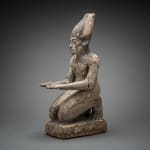Late Period Egyptian wooden statuette of Osiris, 600 BCE - 300 BCE
Wood
41.1 x 19.1 cm
16 1/4 x 7 1/2 in
16 1/4 x 7 1/2 in
PH.0137
Further images
Osiris is one of the most well-known deities of the ancient Egyptian pantheon, often identified as the god of the afterlife, the underworld, and the dead, but more appropriately considered...
Osiris is one of the most well-known deities of the ancient Egyptian pantheon, often identified as the god of the afterlife, the underworld, and the dead, but more appropriately considered as the god of transition, resurrection, and regeneration.
His standard depiction from frescoes shows him as a green-skinned deity, green being associated with rebirth, or with a black complexion, black alluding to the fertile mud of the Nile floodplain, with an attached pharaoh's beard, partially mummy-wrapped by linen bandages around the legs, wearing a distinctive crown with two large ostrich feathers at either side, and holding a symbolic crook and flail.
The shepherd's crook stood for kingship and the flail for the fertility of the land and although they were originally the attributes of Osiris, they subsequently became insignia of pharaonic authority.
Osiris was married to his sister, Isis, a major goddess in ancient Egyptian religion whose worship spread throughout the Greco-Roman world, and was father to Horus, one of the most important Egyptian deities, most often depicted as a lanner or peregrine falcon, or as a man with a falcon head.
His standard depiction from frescoes shows him as a green-skinned deity, green being associated with rebirth, or with a black complexion, black alluding to the fertile mud of the Nile floodplain, with an attached pharaoh's beard, partially mummy-wrapped by linen bandages around the legs, wearing a distinctive crown with two large ostrich feathers at either side, and holding a symbolic crook and flail.
The shepherd's crook stood for kingship and the flail for the fertility of the land and although they were originally the attributes of Osiris, they subsequently became insignia of pharaonic authority.
Osiris was married to his sister, Isis, a major goddess in ancient Egyptian religion whose worship spread throughout the Greco-Roman world, and was father to Horus, one of the most important Egyptian deities, most often depicted as a lanner or peregrine falcon, or as a man with a falcon head.







